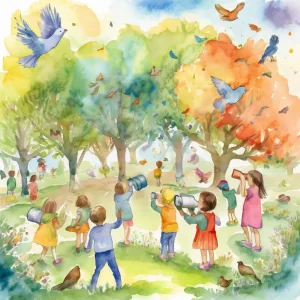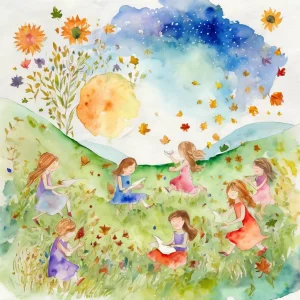Activity
Similar Activities
Nature Shapes Adventure: Bird Watch & Scavenger Hunt
Children’s Age: 4–5 years
Activity Duration: 10 minutes
An outdoor activity for children aged 4-5 years combining bird watching and shape recognition.
Activity Duration: 10 minutes
Enchanted Sound Symphony: Sensory Sound Walk
Children’s Age: 2 months – 3 years
Activity Duration: 5 – 25 minutes
Exploring sounds and textures through a sensory walk outdoors.
Activity Duration: 5 – 25 minutes
Adventure of Rhyme and Move Outdoor Magic
Children’s Age: 3–4 years
Activity Duration: 10 – 25 minutes
"Rhyme and Move Outdoor Adventure" is a fun activity that combines nature-themed rhymes with movement in an outdoor setting. Children get to explore the outdoors, practice language…
Activity Duration: 10 – 25 minutes
Enchanted Glow: Gentle Lights Exploration
Children’s Age: 0 – 6 months
Activity Duration: 5 – 10 minutes
"Gentle Lights Exploration" is an engaging activity tailored for infants aged 0 to 6 months, offering a soothing and enriching sensory experience. Through gentle lights and interac…
Activity Duration: 5 – 10 minutes
Sensory Scarf Play Activity: Colors in Motion
Children’s Age: 3 – 9 months
Activity Duration: 5 minutes
The sensory scarf play activity is ideal for children aged 3 to 9 months, supporting physical development and communication skills. Set up a safe play area with soft, colorful scar…
Activity Duration: 5 minutes
Sensory Nature Walk: A Baby's Adventure Outdoors
Children’s Age: 0 – 6 months
Activity Duration: 10 minutes
Engage infants aged 0 to 6 months in sensory exploration with the Sensory Nature Walk activity. Gather essentials like a baby carrier, sunscreen, and soft toys for a safe outdoor e…
Activity Duration: 10 minutes
Whispers of the Forest: Sensory Scarves Exploration
Children’s Age: 6 months – 1 year
Activity Duration: 5 minutes
Engage infants aged 6 to 12 months in the "Sensory Scarves Exploration" activity, a solo play experience using colorful scarves to promote physical development. Set up a safe play …
Activity Duration: 5 minutes
Picnic Adventure: Pretend Cooking Play for Toddlers
Children’s Age: 2–3 years
Activity Duration: 10 – 30 minutes
An imaginative activity where children (ages 2-3) engage in pretend cooking during a picnic adventure.
Activity Duration: 10 – 30 minutes
Whispers of the Seasons: Seasonal Collage Exploration
Children’s Age: 5–6 years
Activity Duration: 10 minutes
Engaging activity where children create collages representing different seasons.
Activity Duration: 10 minutes
Musical Straw Pan Flute Symphony Adventure
Children’s Age: 6–9 years
Activity Duration: 10 minutes
Create a homemade pan flute using plastic straws to explore music and physics concepts.
Activity Duration: 10 minutes
Digital Beats and Hoop Dreams Coding Adventure
Children’s Age: 9–12 years
Activity Duration: 10 – 20 minutes
An engaging coding activity integrating music production, basketball skills, and teamwork for children aged 9-12 years.
Activity Duration: 10 – 20 minutes
Enchanted Tea Party Adventure: A Magical Journey
Children’s Age: 3 years
Activity Duration: 10 – 15 minutes
Join us for a Magical Tea Party Adventure! Enhance your child's play skills, social-emotional growth, and language abilities through a whimsical tea party experience. Gather teacup…
Activity Duration: 10 – 15 minutes


























